Designed Circularly Polarized Two-Port Microstrip MIMO Antenna for WLAN Applications
Abstract
:1. Introduction
2. Theory and Design
2.1. Single Antenna Design
2.2. MIMO-CP Antenna Design
3. MIMO Antenna Circular Polarization Results
4. Parametric Study
4.1. Changing Length and Width (ls) of the Patch Corner Cut
4.2. Changing the Distance (d) between the Patches
4.3. Changing the Width of the Ground Slot (c)
5. Results and Discussion of MIMO-CP
6. MIMO Antenna System Parameters
6.1. Envelope Correlation Coefficient
6.2. Diversity Gain
7. Conclusions
Author Contributions
Funding
Institutional Review Board Statement
Informed Consent Statement
Data Availability Statement
Acknowledgments
Conflicts of Interest
References
- Kharche, S.; Reddy, G.S.; Gupta, R.K.; Mukherjee, J. Wide band circularly polarised diversity antenna for satellite and mobile communication. IET Microwaves Antennas Propag. 2017, 11, 1861–1867. [Google Scholar] [CrossRef]
- Nouri, M.; Aghdam, S.A. Reconfigurable UWB antenna with electrically control for triple on-demand rejection bandwidth. Microw. Opt. Technol. Lett. 2015, 57, 1894–1897. [Google Scholar] [CrossRef]
- Bait-Suwailam, M.M.; Siddiqui, O.F.; Ramahi, O.M. Mutual coupling reduction between microstrip patch antennas using slotted-complementary split-ring resonators. IEEE Antennas Wirel. Propag. Lett. 2010, 9, 876–878. [Google Scholar] [CrossRef]
- Ketzaki, D.A.; Yioultsis, T.V. Metamaterial-based design of planar compact MIMO monopoles. IEEE Trans. Antennas Propag. 2013, 61, 2758–2766. [Google Scholar] [CrossRef]
- Yang, F.; Rahmat-Samii, Y. Microstrip antennas integrated with electromagnetic band-gap (EBG) structures: A low mutual coupling design for array applications. IEEE Trans. Antennas Propag. 2003, 51, 2936–2946. [Google Scholar] [CrossRef] [Green Version]
- Kamal, M.M.; Ullah, I.; Ashraf, A.; Ullah, N. Designing band notch features in ultra-wideband antenna. In Proceedings of the 2017 7th IEEE International Symposium on Microwave, Antenna, Propagation, and EMC Technologies (MAPE), Xi’an, China, 24–27 October 2017; pp. 92–95. [Google Scholar]
- Rajo-Iglesias, E.; Quevedo-Teruel, O.; Inclan-Sanchez, L. Mutual coupling reduction in patch antenna arrays by using a planar EBG structure and a multilayer dielectric substrate. IEEE Trans. Antennas Propag. 2008, 56, 1648–1655. [Google Scholar] [CrossRef]
- Ibrahim, A.A.; Abdalla, M.A.; Abdel-Rahman, A.B.; Hamed, H.F. Compact MIMO antenna with optimized mutual coupling reduction using DGS. Int. J. Microw. Wirel. Technol. 2014, 6, 173–180. [Google Scholar] [CrossRef]
- Kamal, S.; Chaudhari, A. Printed Meander Line MIMO Antenna Integrated with Air Gap, DGS and RIS: Low mutual coupling design for LTE Applications. Prog. Electromagn. Res. C 2017, 71, 149–159. [Google Scholar] [CrossRef] [Green Version]
- Yang, Y.; Chu, Q.; Mao, C. Multiband MIMO antenna for GSM, DCS, and LTE indoor applications. IEEE Antennas Wirel. Propag. Lett. 2016, 15, 1573–1576. [Google Scholar] [CrossRef]
- Jabire, A.H.; Abdu, A.; Saminu, S.; Salisu, S.; Sadiq, A.M.; Jajere, A.M.; Ahmed, Y.K. Reduction of Mutual Coupling in UWB/MIMO Antenna Using Stub Loading Technique. Electr. Control. Commun. Eng. 2021, 17, 12–18. [Google Scholar] [CrossRef]
- OuYang, J.; Yang, F.; Wang, Z. Reducing mutual coupling of closely spaced microstrip MIMO antennas for WLAN application. IEEE Antennas Wirel. Propag. Lett. 2011, 10, 310–313. [Google Scholar] [CrossRef]
- Jabire, A.H.; Ghaffar, A.; Li, X.J.; Abdu, A.; Saminu, S.; Alibakhshikenari, M.; Falcone, F.; Limiti, E. Metamaterial Based Design of Compact UWB/MIMO Monopoles Antenna with Characteristic Mode Analysis. Appl. Sci. 2021, 11, 1542. [Google Scholar] [CrossRef]
- Mookiah, P.; Dandekar, K.R. Metamaterial-substrate antenna array for MIMO communication system. IEEE Trans. Antennas Propag. 2009, 57, 3283–3292. [Google Scholar] [CrossRef]
- Tiwari, R.N.; Singh, P.; Kanaujia, B.K.; Kumar, P. Compact circularly polarized MIMO printed antenna with novel ground structure for wideband applications. Int. J. Microw. Comput. Aided Eng. 2021, 31, e22737. [Google Scholar] [CrossRef]
- Balanis, C.A. Antenna Theory: Analysis and Design; John Wiley & Sons: Hoboken, NJ, USA, 2015. [Google Scholar]
- Sharawi, M.S. Current misuses and future prospects for printed multiple-input, multiple-output antenna systems [wireless corner]. IEEE Antennas Propag. Mag. 2017, 59, 162–170. [Google Scholar] [CrossRef]
- Khan, I.; Tian, Y.B.; Vllah, H.; Rahman, S.U.; Kamal, M.M. Design annular ring microstrip antenna based on artificial neural network. In Proceedings of the 2018 2nd IEEE Advanced Information Management, Communicates, Electronic and Automation Control Conference (IMCEC), Xi’an, China, 25–27 May 2018; pp. 2033–2037. [Google Scholar]
- Jiang, W.; Yang, L.; Wang, B.; Gong, S. A high isolation dual-band MIMO antenna for WLAN application. In Proceedings of the 2017 International Symposium on Antennas and Propagation (ISAP), Phuket, Thailand, 30 October–2 November 2017; pp. 1–2. [Google Scholar]
- Gil-Martínez, A.; El Gholb, Y.; Poveda-García, M.; Gómez-Tornero, J.L.; El Idrissi, N.E.A. An Array of Leaky Wave Antennas for Indoor Smart Wireless Access Point Applications. In Proceedings of the 2019 International Conference on Wireless Networks and Mobile Communications (WINCOM), Fez, Morocco, 29 October–1 November 2019; pp. 1–4. [Google Scholar]
- Vakilian, V.; Frigon, J.F.; Roy, S. On increasing the slow-fading channel diversity using block-coded mimo-ofdm with reconfigurable antennas. IEEE Trans. Veh. Technol. 2015, 65, 7207–7218. [Google Scholar] [CrossRef]
- Frigon, J.F.; Caloz, C.; Zhao, Y. Dynamic radiation pattern diversity (DRPD) MIMO using CRLH leaky-wave antennas. In Proceedings of the 2008 IEEE Radio and Wireless Symposium, Orlando, FL, USA, 22–24 January 2008; pp. 635–638. [Google Scholar]
- Sharma, Y.; Sarkar, D.; Saurav, K.; Srivastava, K.V. Three-element MIMO antenna system with pattern and polarization diversity for WLAN applications. IEEE Antennas Wirel. Propag. Lett. 2016, 16, 1163–1166. [Google Scholar] [CrossRef]
- Chouhan, S.; Panda, D.K.; Gupta, M.; Singhal, S. Meander line MIMO antenna for 5.8 GHz WLAN application. Int. J. Microw. Comput. Aided Eng. 2018, 28, e21222. [Google Scholar] [CrossRef]
- Malik, J.; Nagpal, D.; Kartikeyan, M. MIMO antenna with omnidirectional pattern diversity. Electron. Lett. 2016, 52, 102–104. [Google Scholar] [CrossRef]
- Khan, I.; Tian, Y.b.; Ullah, I.; Kamal, M.M.; Ullah, H.; Khan, A. Designing of E-shaped microstrip antenna using artificial neural network. Int. J. Comput. Commun. Instrum. Eng. 2018, 5, 23–26. [Google Scholar]
- Qin, P.Y.; Guo, Y.J.; Liang, C.H. Effect of antenna polarization diversity on MIMO system capacity. IEEE Antennas Wirel. Propag. Lett. 2010, 9, 1092–1095. [Google Scholar] [CrossRef]
- Ullah, U.; Koziel, S. A novel coplanar-strip-based excitation technique for design of broadband circularly polarization antennas with wide 3 dB axial ratio beamwidth. IEEE Trans. Antennas Propag. 2019, 67, 4224–4229. [Google Scholar] [CrossRef]
- Subhanrao Bhadade, R.; Padmakar Mahajan, S. Circularly polarized 4 × 4 MIMO antenna for WLAN applications. Electromagnetics 2019, 39, 325–342. [Google Scholar] [CrossRef]
- Tran, H.H.; Hussain, N.; Le, T.T. Low-profile wideband circularly polarized MIMO antenna with polarization diversity for WLAN applications. AEU-Int. J. Electron. Commun. 2019, 108, 172–180. [Google Scholar] [CrossRef]
- Kim-Thi, P.; Tran, H.H.; Le, T.T. Circularly polarized MIMO antenna utilizing parasitic elements for simultaneous improvements in isolation, bandwidth and gain. AEU-Int. J. Electron. Commun. 2021, 135, 153727. [Google Scholar] [CrossRef]
- Qu, L.; Piao, H.; Qu, Y.; Kim, H.H.; Kim, H. Circularly polarised MIMO ground radiation antennas for wearable devices. Electron. Lett. 2018, 54, 189–190. [Google Scholar] [CrossRef]
- Sahu, N.K.; Das, G.; Gangwar, R.K. L-shaped dielectric resonator based circularly polarized multi-input-multi-output (MIMO) antenna for wireless local area network (WLAN) applications. Int. J. Microw. Comput. Aided Eng. 2018, 28, e21426. [Google Scholar] [CrossRef]
- Jamal, M.Y.; Li, M.; Yeung, K.L. Isolation enhancement of closely packed dual circularly polarized MIMO antenna using hybrid technique. IEEE Access 2020, 8, 11241–11247. [Google Scholar] [CrossRef]
- Iqbal, A.; A Saraereh, O.; Bouazizi, A.; Basir, A. Metamaterial-based highly isolated MIMO antenna for portable wireless applications. Electronics 2018, 7, 267. [Google Scholar] [CrossRef] [Green Version]
- Pandit, S.; Mohan, A.; Ray, P. A compact four-element MIMO antenna for WLAN applications. Microw. Opt. Technol. Lett. 2018, 60, 289–295. [Google Scholar] [CrossRef]
- Ayinala, K.D.; Sahu, P.K. A Compact Slit-loaded Modified Slot Antenna Based Quad-port MIMO Antenna for WLAN Applications. In Proceedings of the 2020 IEEE 7th Uttar Pradesh Section International Conference on Electrical, Electronics and Computer Engineering (UPCON), Prayagraj, India, 27–29 November 2020; pp. 1–6. [Google Scholar]
- Malviya, L.; Panigrahi, R.K.; Kartikeyan, M. Circularly polarized 2 × 2 MIMO antenna for WLAN applications. Prog. Electromagn. Res. C 2016, 66, 97–107. [Google Scholar] [CrossRef] [Green Version]
- Nayan, M.; Jamlos, M.; Jamlos, M. Circularly polarized MIMO antenna array for point-to-point communication. Microw. Opt. Technol. Lett. 2015, 57, 242–247. [Google Scholar] [CrossRef]
- Varshney, G.; Singh, R.; Pandey, V.S.; Yaduvanshi, R.S. Circularly polarized two-port MIMO dielectric resonator antenna. Prog. Electromagn. Res. M 2020, 91, 19–28. [Google Scholar] [CrossRef]
- Sharma, K.; Pandey, G.P. Two port compact MIMO antenna for ISM band applications. Prog. Electromagn. Res. C 2020, 100, 173–185. [Google Scholar] [CrossRef] [Green Version]
- Dwivedi, A.K.; Sharma, A.; Pandey, A.K.; Singh, V. Two Port Circularly Polarized MIMO Antenna Design and Investigation for 5G Communication Systems. Wirel. Pers. Commun. 2021, 120, 2085–2099. [Google Scholar] [CrossRef]
- Adam, I.; Yasin, M.N.M.; Ramli, N.; Jusoh, M.; Rahim, H.A.; Latef, T.B.A.; Izam, T.F.T.M.N.; Sabapathy, T. Mutual coupling reduction of a wideband circularly polarized microstrip MIMO antenna. IEEE Access 2019, 7, 97838–97845. [Google Scholar] [CrossRef]
- Sharma, Y.; Sarkar, D.; Saurav, K.; Srivastava, K.V. A compact two element MIMO antenna system for pattern and polarization diversity. In Proceedings of the 2016 IEEE Uttar Pradesh Section International Conference on Electrical, Computer and Electronics Engineering (UPCON), Varanasi, India, 9–11 December 2016; pp. 660–664. [Google Scholar]
- Sahu, N.K.; Das, G.; Gangwar, R.K. Dielectric resonator based MIMO antenna with circular polarization diversity for WiMAX applications. In Proceedings of the 2019 PhotonIcs & Electromagnetics Research Symposium-Spring (PIERS-Spring), Rome, Italy, 17–20 June 2019; pp. 604–612. [Google Scholar]
- Malik, J.; Patnaik, A.; Kartikeyan, M. Novel printed MIMO antenna with pattern and polarization diversity. IEEE Antennas Wirel. Propag. Lett. 2014, 14, 739–742. [Google Scholar] [CrossRef]
- Kaur, M.; Singh, H.S. Design and analysis of high isolated super compact 2 × 2 MIMO antenna for WLAN application. Int. J. Microw. Comput. Aided Eng. 2021, 31, e22864. [Google Scholar] [CrossRef]
- Blanch, S.; Romeu, J.; Corbella, I. Exact representation of antenna system diversity performance from input parameter description. Electron. Lett. 2003, 39, 705–707. [Google Scholar] [CrossRef] [Green Version]
- Abdullah, M.; Kiani, S.H.; Iqbal, A. Eight element multiple-input multiple-output (MIMO) antenna for 5G mobile applications. IEEE Access 2019, 7, 134488–134495. [Google Scholar] [CrossRef]
- Ullah, H.; Rahman, S.U.; Cao, Q.; Khan, I.; Ullah, H. Design of SWB MIMO antenna with extremely wideband isolation. Electronics 2020, 9, 194. [Google Scholar] [CrossRef] [Green Version]
- Sharawi, M.S. Printed MIMO Antenna Engineering; Artech House: London, UK, 2014. [Google Scholar]
- Hwangbo, S.; Yang, H.Y.; Yoon, Y.K. Mutual coupling reduction using micromachined complementary meander-line slots for a patch array antenna. IEEE Antennas Wirel. Propag. Lett. 2017, 16, 1667–1670. [Google Scholar] [CrossRef]
- Das, G.; Sharma, A.; Gangwar, R.K. Dielectric resonator based circularly polarized MIMO antenna with polarization diversity. Microw. Opt. Technol. Lett. 2018, 60, 685–693. [Google Scholar] [CrossRef]
- Kumar, V. Rectangular DR-based dual-band CP-MIMO antenna with inverted Z-shaped slot. Int. J. Electron. 2020, 107, 1559–1573. [Google Scholar] [CrossRef]
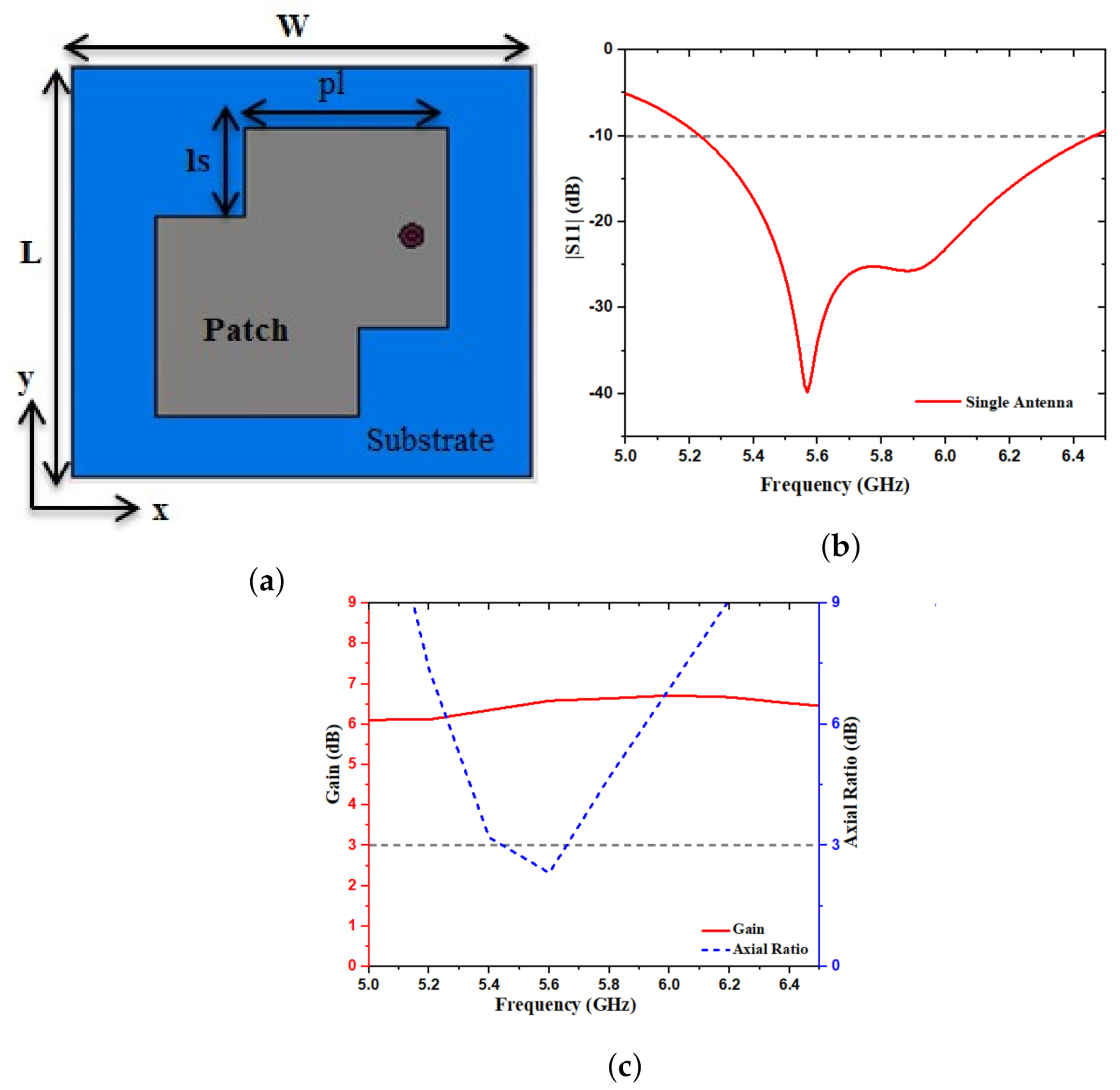

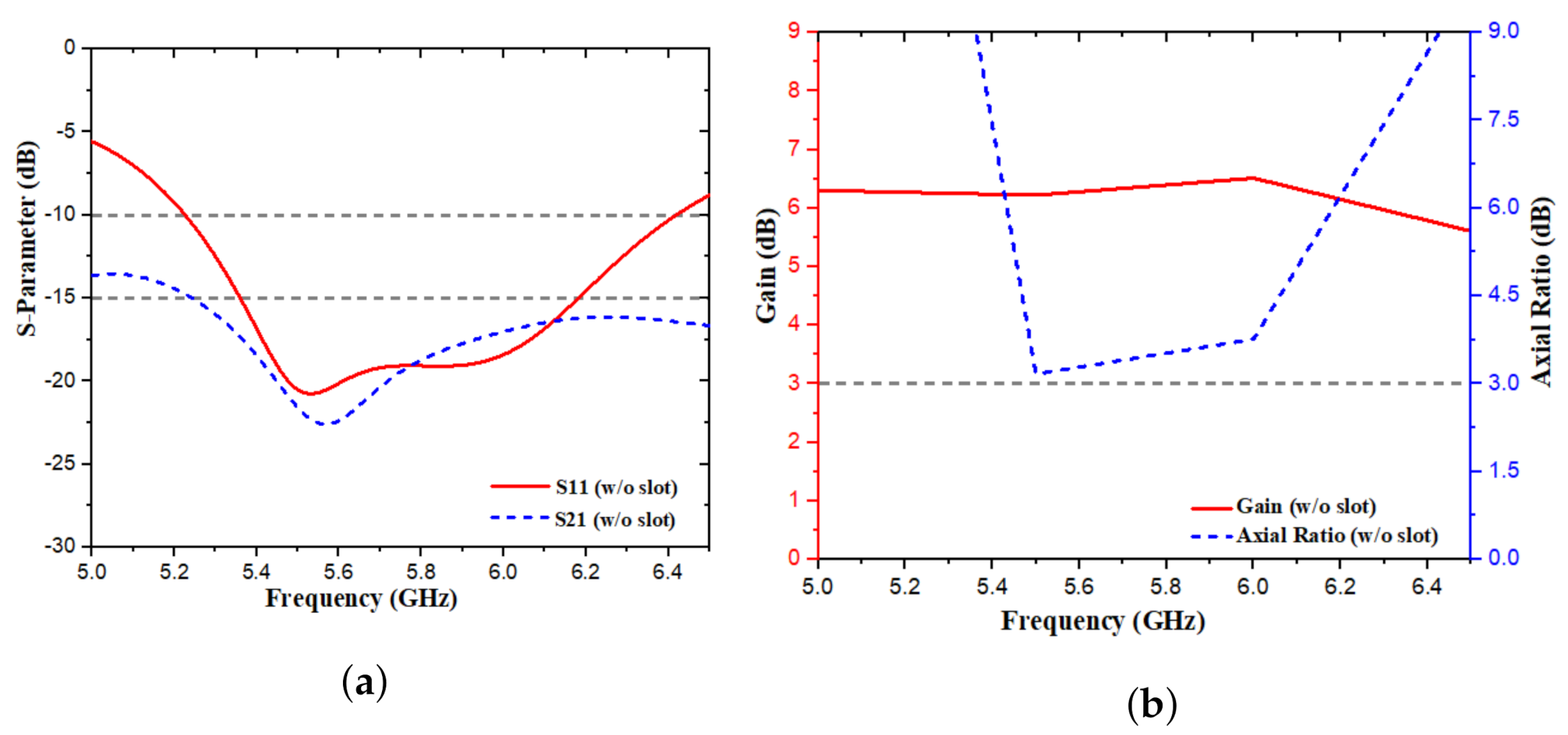


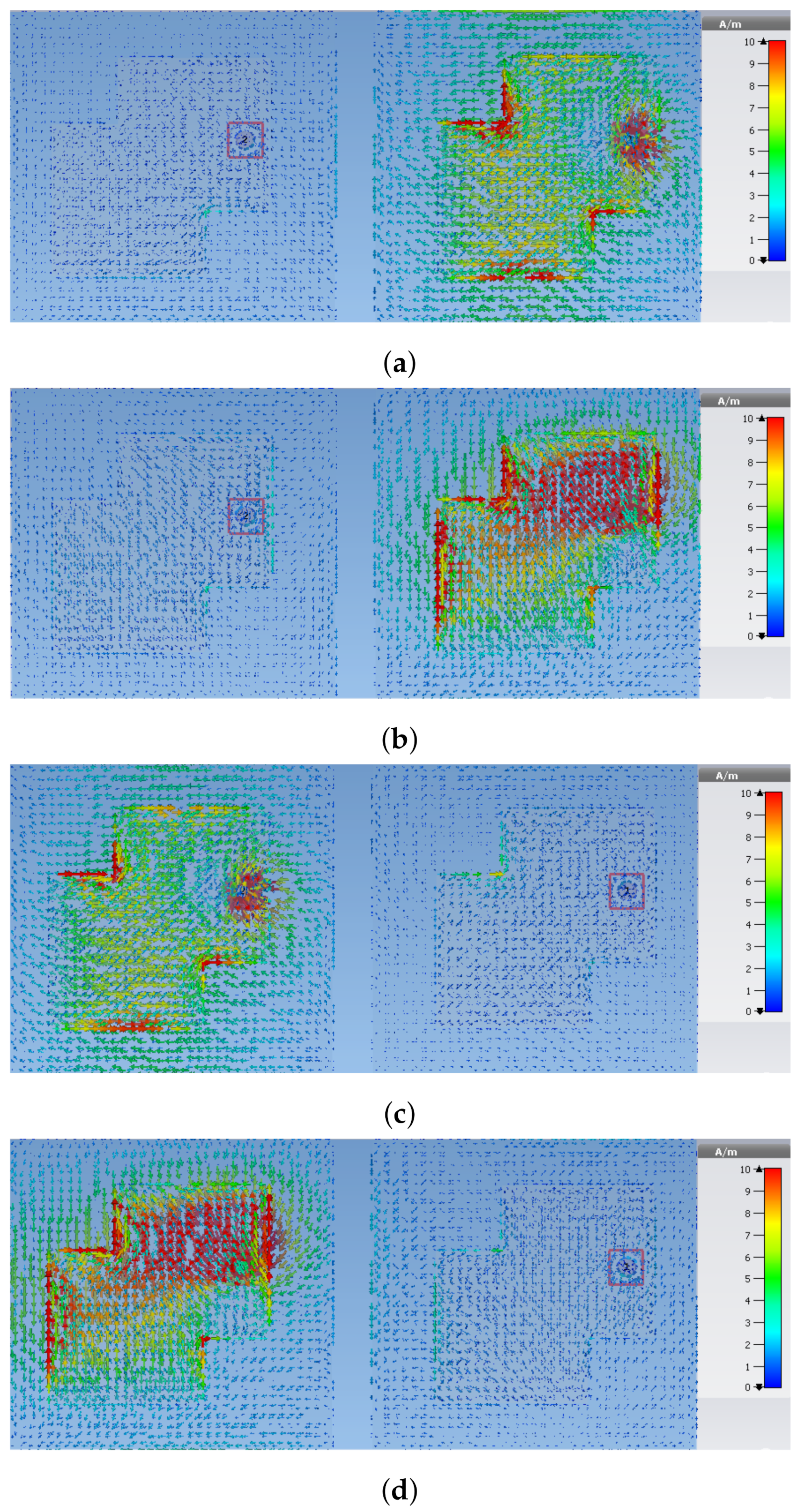




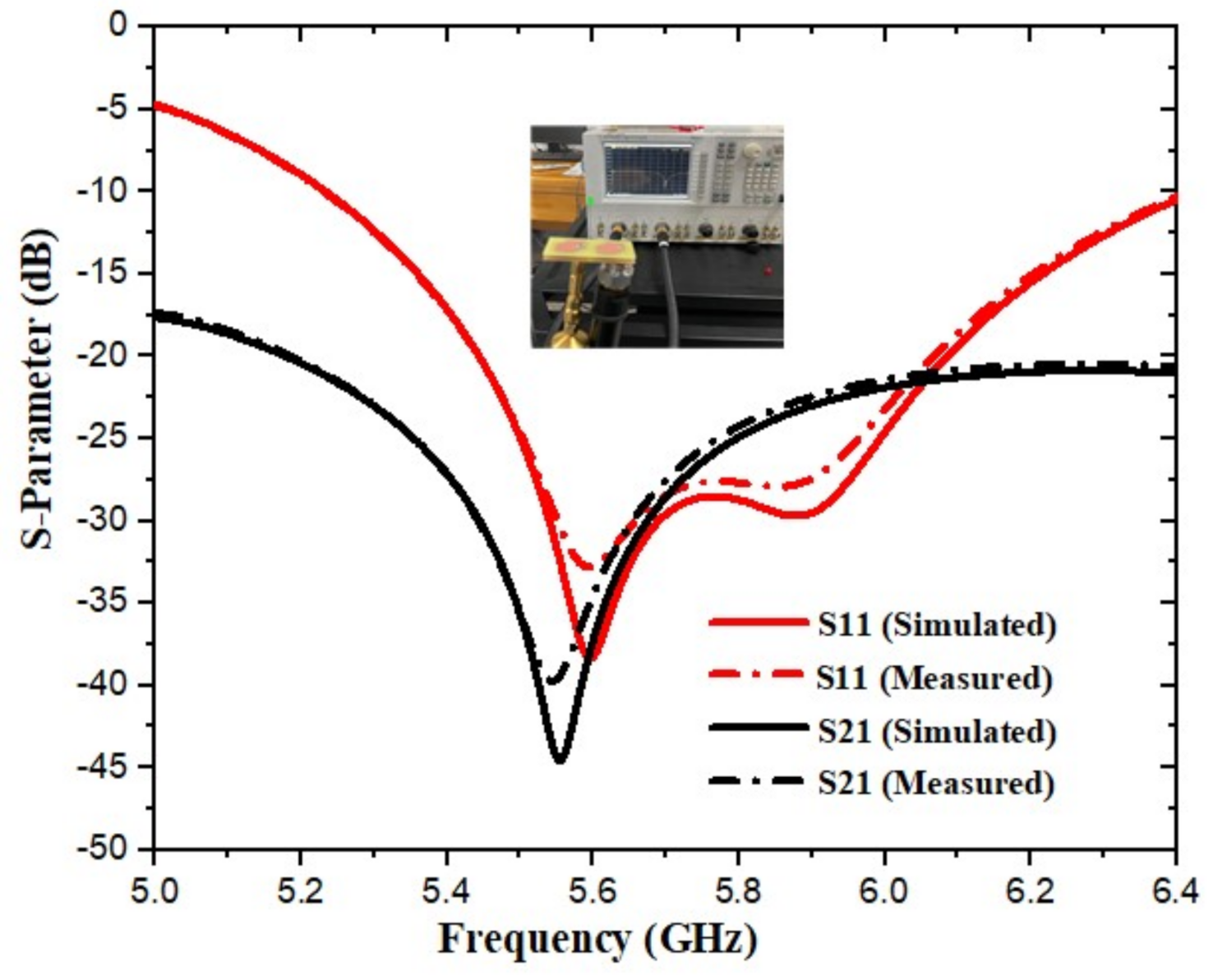
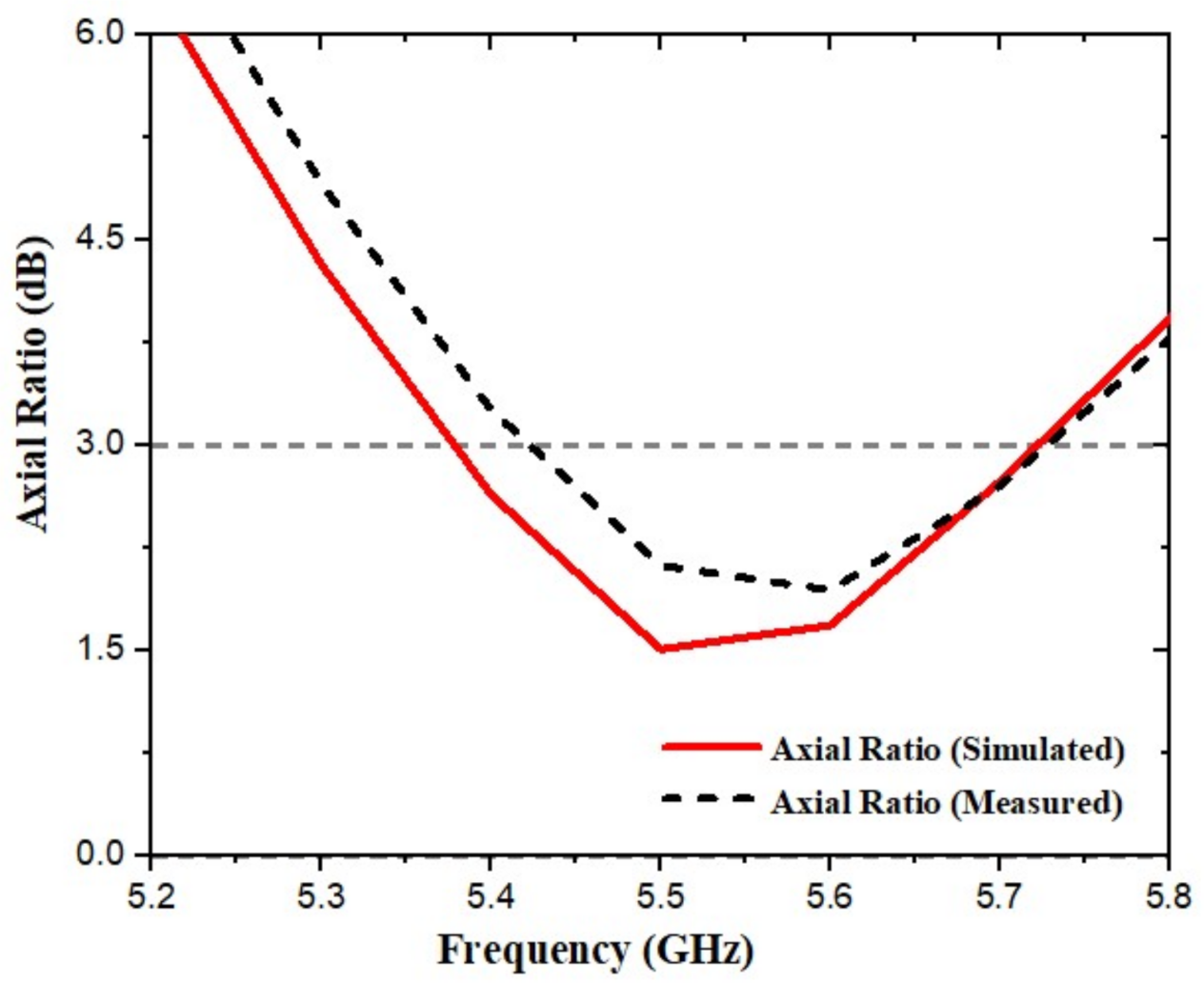
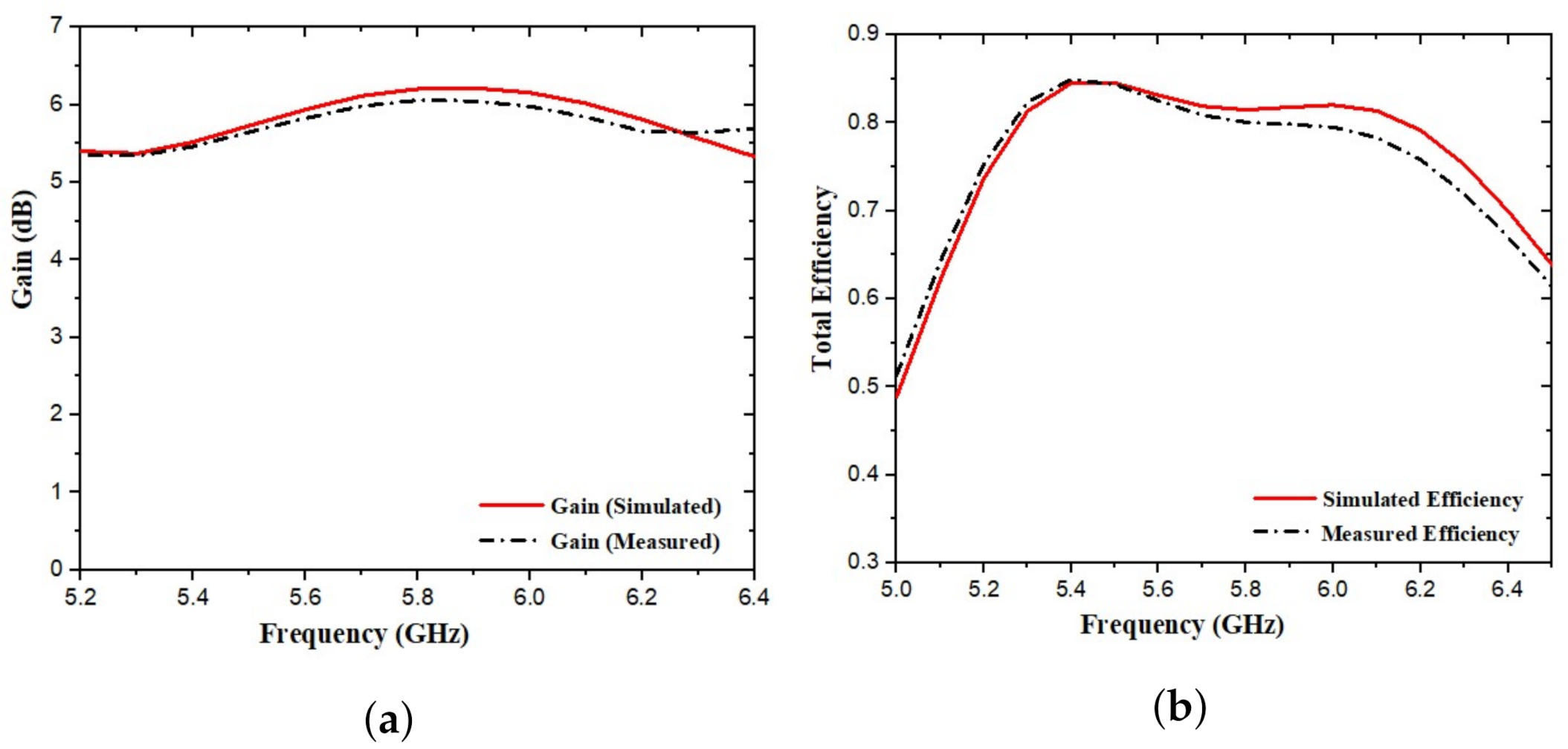
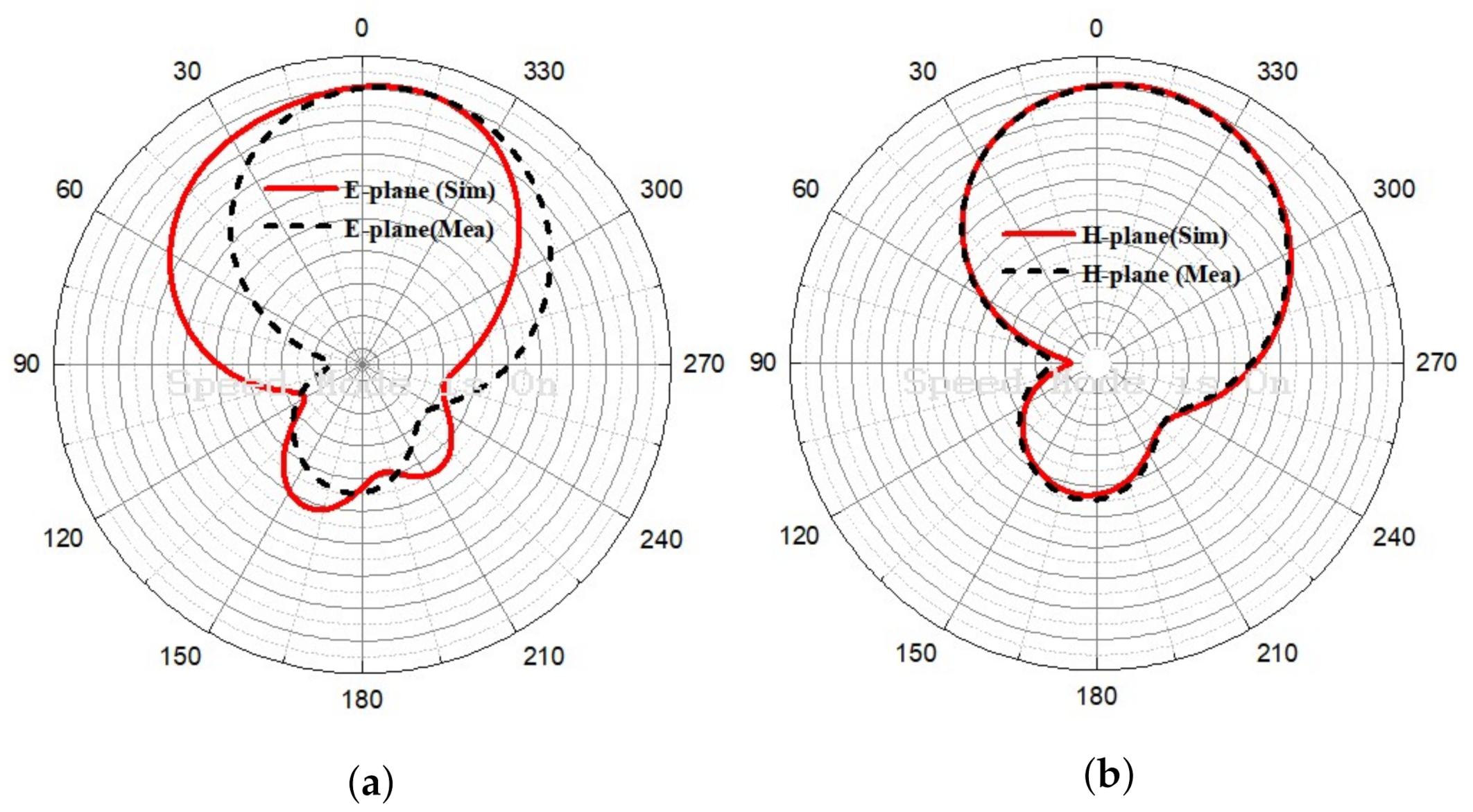
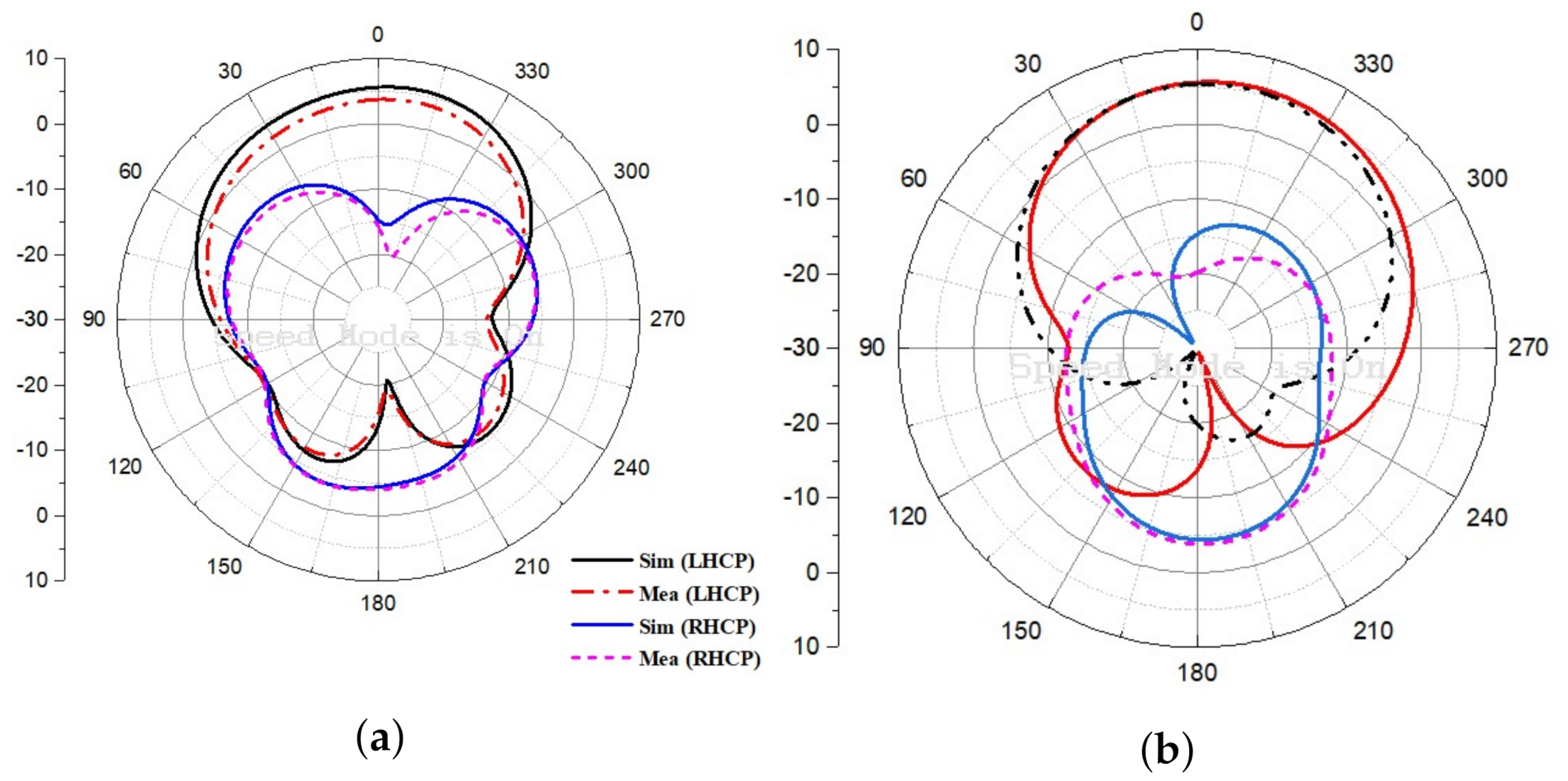
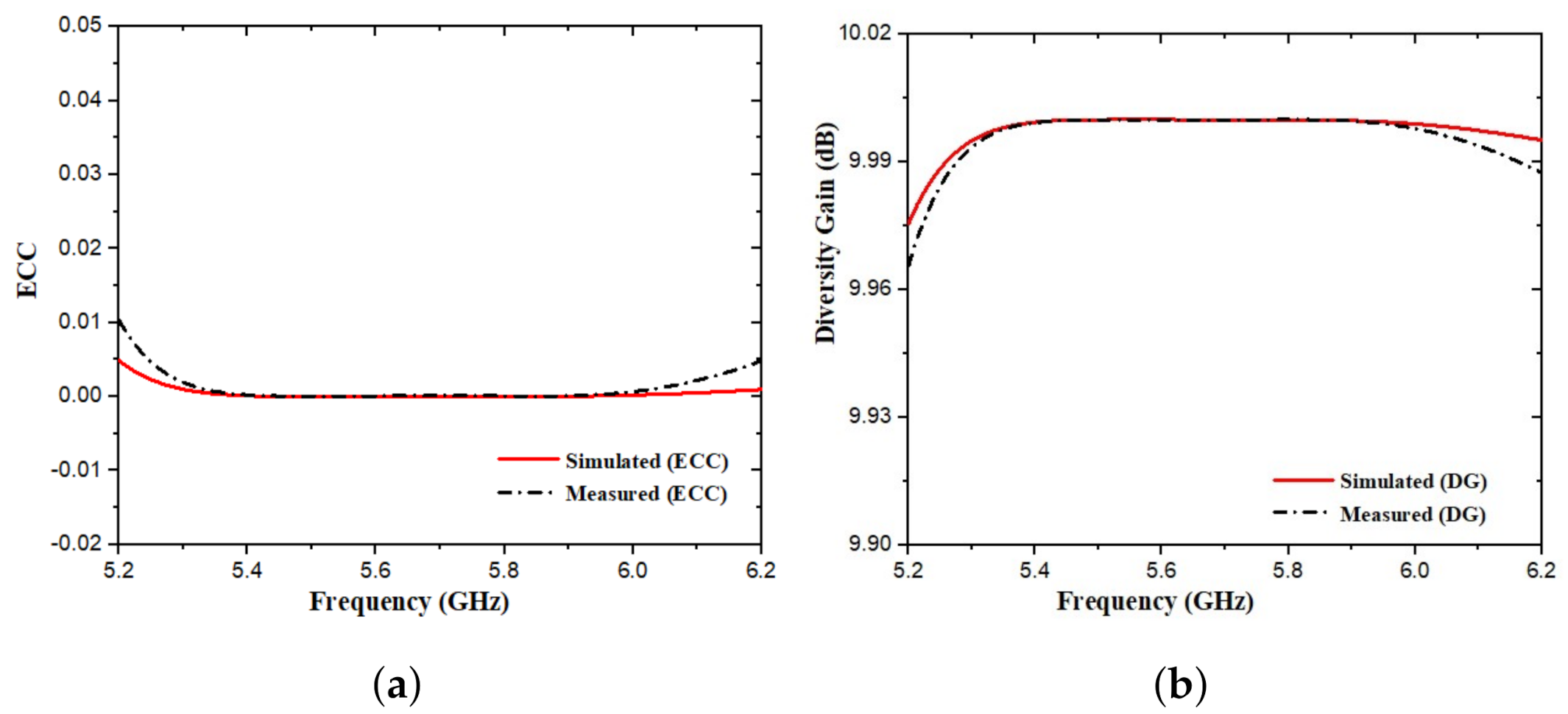
| Parameters | Dimensions (mm) | Parameters | Dimensions (mm) | Parameters | Dimensions (mm) |
|---|---|---|---|---|---|
| W | 50 | L | 22.5 | 11 | |
| 3.1 | 3.5 | d | 12.2 | ||
| c | 1.5 | h | 1.6 | g | 11.25 |
| Reference | Central Frequency (GHz) | Peak Isolation (dB) | Bandwidth (GHz) | ARBW CP/LP | Gain (dB) | Size (mm) |
|---|---|---|---|---|---|---|
| [23] | 5.7 | 18 | 5.5–6.1 | 5.52–5.64 | 2.85 | |
| [33] | 5.5 | 22.5 | 5.2–6.08 | 5.2–5.58 | 4.0 | |
| [35] | 5.8 | 24.5 | 5.61–5.93 | LP | 4.0 | |
| [36] | 5.7 | 15.4 | 5.6–5.8 | LP | 1.41 | |
| [37] | 5.2 | 15 | 5.05–5.35 | LP | 1.40 | |
| [38] | 5.8 | 35 | 5.4–6.08 | 5.72–5.815 | 5.3 | |
| [40] | 6.44 | 15 | 5.71–8.2 | 7.72–8.08 | 3.8 | |
| [41] | 2.44 | 24.6 | 2.43–2.50 | LP | 4.68 | |
| [42] | 3.7 | 15 | 3.3–4.2 | 3.2–4.25 | 2.5 | |
| [43] | 2.08 | 24 | 1.82–2.57 | 2.04–2.5 | 4.0 | |
| [44] | 5.8 | 20 | 5.5–5.85 | 5.59–5.71 | 3.92 | |
| [45] | 3.5 | 21 | 3.38–3.80 | 3.340–3.57 | 4.91 | |
| [46] | 5.6 | 14 | 5.5–6.08 | 5.5–5.9 | 4.4 | |
| [47] | 5.65 | 25 | 5.2–6.0 | LP | Nil | |
| Proposed work | 5.6 | 37 | 5.2–6.4 | 5.37–5.72 | 6 |
Publisher’s Note: MDPI stays neutral with regard to jurisdictional claims in published maps and institutional affiliations. |
© 2022 by the authors. Licensee MDPI, Basel, Switzerland. This article is an open access article distributed under the terms and conditions of the Creative Commons Attribution (CC BY) license (https://creativecommons.org/licenses/by/4.0/).
Share and Cite
Khan, I.; Wu, Q.; Ullah, I.; Rahman, S.U.; Ullah, H.; Zhang, K. Designed Circularly Polarized Two-Port Microstrip MIMO Antenna for WLAN Applications. Appl. Sci. 2022, 12, 1068. https://doi.org/10.3390/app12031068
Khan I, Wu Q, Ullah I, Rahman SU, Ullah H, Zhang K. Designed Circularly Polarized Two-Port Microstrip MIMO Antenna for WLAN Applications. Applied Sciences. 2022; 12(3):1068. https://doi.org/10.3390/app12031068
Chicago/Turabian StyleKhan, Ijaz, Qun Wu, Inam Ullah, Saeed Ur Rahman, Habib Ullah, and Kuang Zhang. 2022. "Designed Circularly Polarized Two-Port Microstrip MIMO Antenna for WLAN Applications" Applied Sciences 12, no. 3: 1068. https://doi.org/10.3390/app12031068
APA StyleKhan, I., Wu, Q., Ullah, I., Rahman, S. U., Ullah, H., & Zhang, K. (2022). Designed Circularly Polarized Two-Port Microstrip MIMO Antenna for WLAN Applications. Applied Sciences, 12(3), 1068. https://doi.org/10.3390/app12031068










